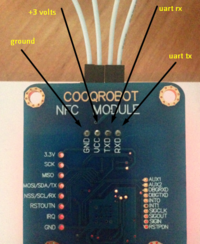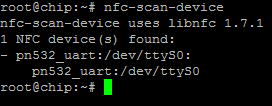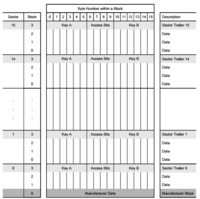Investigating nfc cards: Difference between revisions
No edit summary |
|||
| (One intermediate revision by the same user not shown) | |||
| Line 2: | Line 2: | ||
In this brief document i will attempt to explain how to setup your chip and pn532 NFC reader to poke around with NFc cars. | In this brief document i will attempt to explain how to setup your chip and pn532 NFC reader to poke around with NFc cars. | ||
== Setup == | === Setup === | ||
After flashing[https://flash.getchip.com/] your chip, first thing yo need to do is install ''libnfc'' by running command | After flashing[https://flash.getchip.com/] your chip, first thing yo need to do is install ''libnfc'' by running command | ||
| Line 19: | Line 19: | ||
[[File:Nfc-scan-device.png]] | [[File:Nfc-scan-device.png]] | ||
== Identifying cards == | === Identifying cards === | ||
Using this command you can check if reader detects NFC card successfully | Using this command you can check if reader detects NFC card successfully | ||
nfc-list | nfc-list | ||
| Line 31: | Line 31: | ||
Nfc-list.png|nfc-list output | Nfc-list.png|nfc-list output | ||
</gallery> | </gallery> | ||
=== Basic working principles of Mifare Classic card === | |||
Both, ISIC and Estonian transportation cards are working on Mifare Classic chip. Bank cards use another chip which is able to emulate Mifare Classic. SEB uses Mifare Plus and Swedbank uses JCOP as far as i know. | |||
Mifare classic`s memory is organized in 16 sectors of 4 blocks. One block contains 16 bytes. | |||
[[File:Mifare_classic_memory_layout.png|200px]] | |||
Latest revision as of 23:05, 11 April 2017
Investigating Mifare NFC cards with PN532 module and C.H.I.P
In this brief document i will attempt to explain how to setup your chip and pn532 NFC reader to poke around with NFc cars.
Setup
After flashing[1] your chip, first thing yo need to do is install libnfc by running command
apt-get install libnfc-bin
And add your NFC device
mkdir -p /etc/nfc/devices.d/ echo -e "name = \"PN532 board via UART\" \nconnstring = pn532_uart:/dev/ttyS0" > /etc/nfc/devices.d/pn532_uart.conf
Now you actually need to connect reader to chip. Check attached picture to see where to connect each pin.
If you did everything right, you should be able to detect the device by running
nfc-scan-device
Identifying cards
Using this command you can check if reader detects NFC card successfully
nfc-list
You can identify cards by returned ATQA/SENS_RES, SAK/SEL_RES and ATS[2] bytes manually by useing command
nfc-list
or you can use this utility[3] to make it easier. Below you can see responses from ISIC card (non bank issued one).
-
lsnfc output
-
nfc-list output
Basic working principles of Mifare Classic card
Both, ISIC and Estonian transportation cards are working on Mifare Classic chip. Bank cards use another chip which is able to emulate Mifare Classic. SEB uses Mifare Plus and Swedbank uses JCOP as far as i know.
Mifare classic`s memory is organized in 16 sectors of 4 blocks. One block contains 16 bytes.



